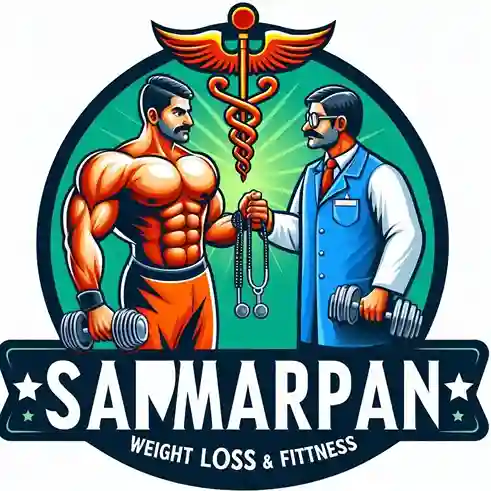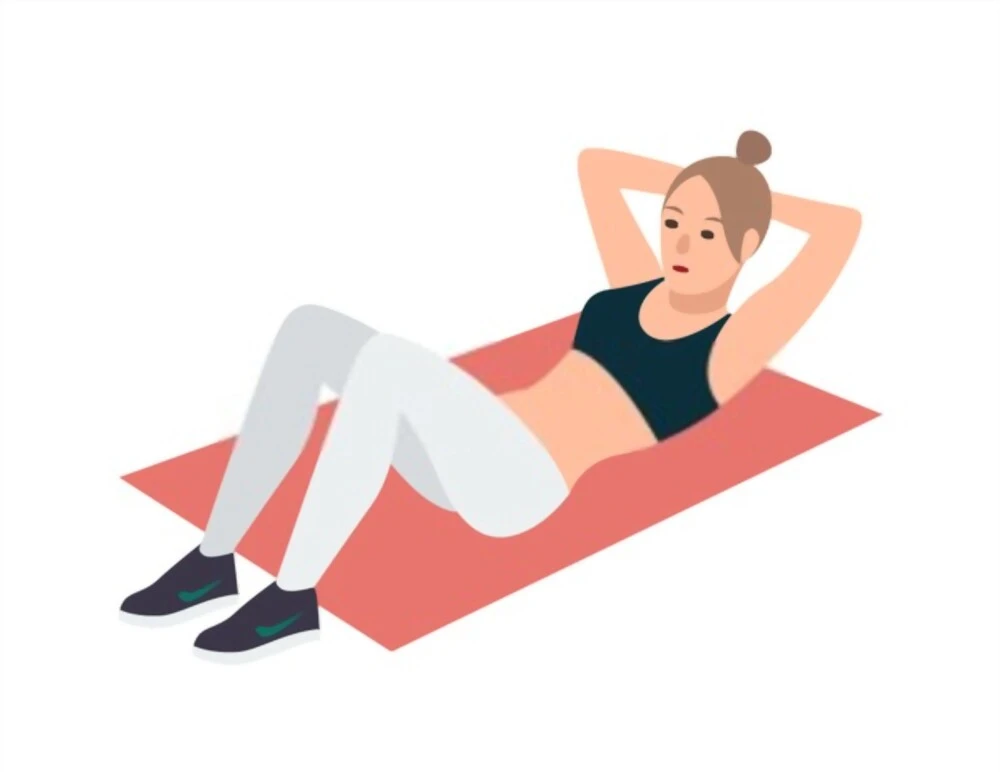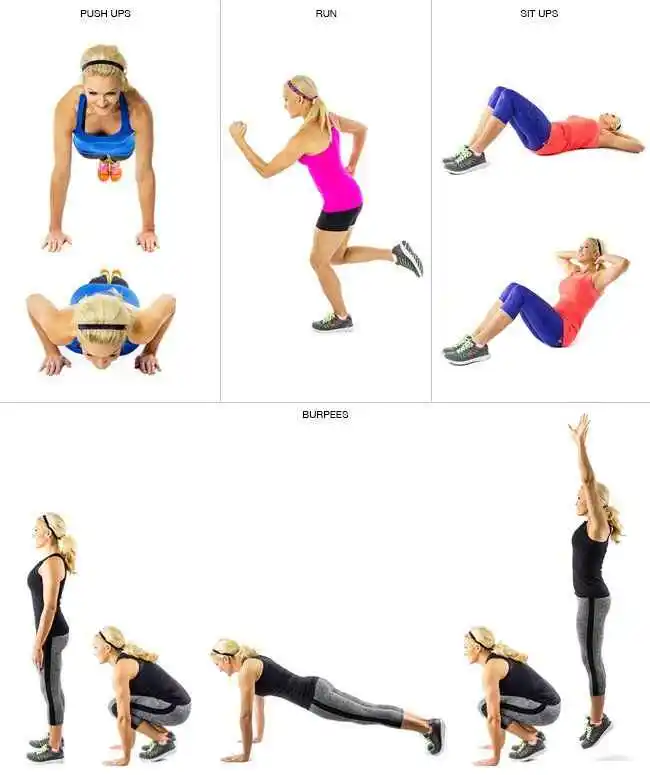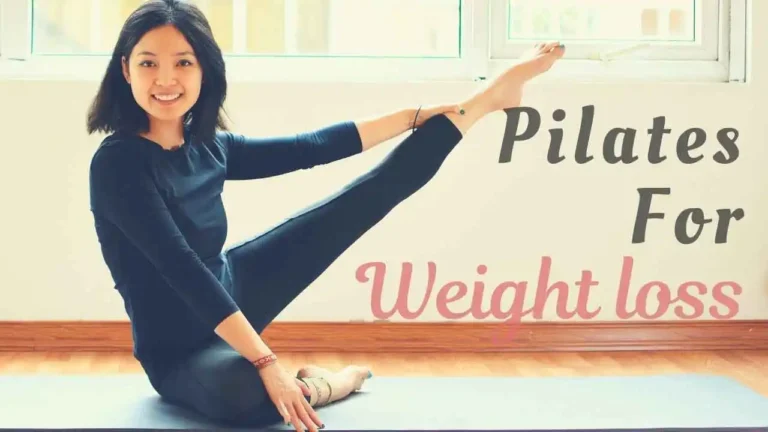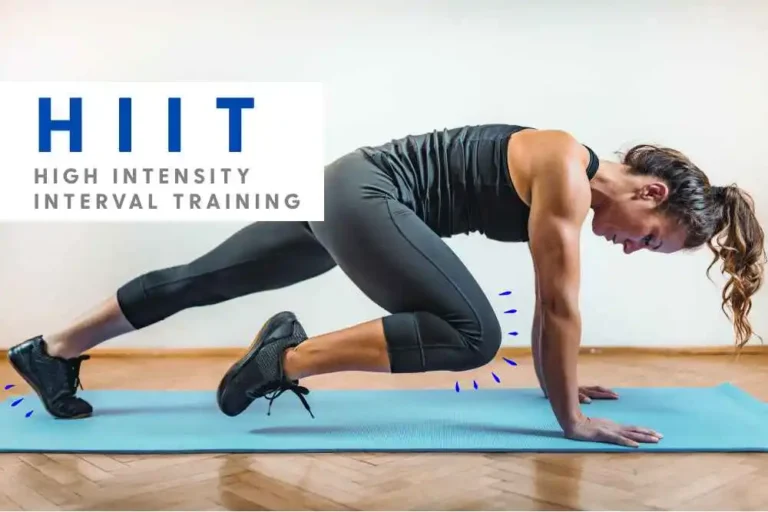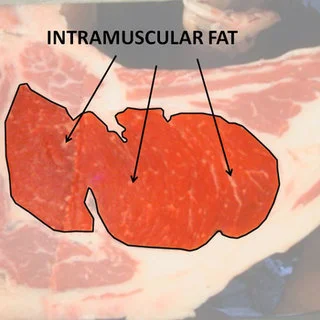Curl-Ups Exercise (Sit-Ups)
Curl-ups, commonly known as sit-ups, are a classic core-strengthening exercise that targets the abdominal muscles. This exercise involves lying on your back, bending your knees, and curling your upper body toward your thighs.
Curl-ups effectively build core stability, improve posture, and enhance overall body strength. They are versatile workouts that can be performed with minimal equipment, making them a popular choice for fitness routines at home or in the gym.
Proper technique is essential to avoid strain and maximize benefits, making them a staple for developing a strong and toned core.
What is the Curl-Ups exercise?
- The curl-up is a good workout to strengthen the muscles in your abdomen.
- The development of the abdominal muscles is the aim of this exercise.
- A common stomach workout is the “curl-up,” which involves raising your upper body while lying on your back.
- This workout uses your body weight to build and tone the muscles in your abdomen that support your core.
- Your rectus abdominis, transverse abdominis, obliques, hip flexors, chest, and neck muscles all work during a curl-up.
- With this exercise, you can engage your gluteal and lower back muscles to assist you keep your posture correct.
- Compared to curl-ups, which offer a broader range of motion, crunches, and solid core workouts train more muscles.
- This exercise would be very beneficial to your fitness plan.
- Curl-ups are sometimes known as abdominal crunches or sit-ups.
which muscles are used in Curl ups Exercise?
- Rectus Abdominis
- Obliques
- Transverse Abdominis
- Hip Flexors
- Quadriceps
- Erector Spinae
What are the Health Benefits of curl-up Exercise?
Because of their effectiveness and ease of use, traditional core exercises like curl-ups are frequently included in fitness programs.
Improve Core muscle strength
- One of the main reasons to perform curl-ups is to have strong core muscles.
- By strengthening, toning, and tightening your core, you can lower your risk of injury and back pain.
- You’ll be able to move freely while you go about your daily activities, including sports and athletics.
Helps to Improve muscle mass
- Your hip and abdominal muscles get stronger when you perform curl-ups.
- Exercise that involves curling up could be a helpful sign of muscle loss (sarcopenia, or age-related muscle loss).
- Muscle mass and functional ability were higher in those who could perform more than ten curl-ups.
Helps to improve performance in sports activity
- A stronger core muscle improves stability and posture, which enables athletes and sportsmen to perform better in any physical activity or sport and reduces tiredness.
Improve balance and stability
- As you move through your everyday routines and athletic endeavors, a strong core muscle helps you stay balanced and stable.
- This exercise may improve the coordination of your hip, lower back, and pelvic muscles with your core muscles.
Helps to Improve flexibility
- This workout Your hips and spine will become less stiff if you move your spine.
- Your hips and trunk become more flexible during curl-ups, which improves mobility and eases back strain and tightness.
- A more flexible muscle enhances circulation, lowers stress, and increases vitality.
Improved posture
- A strong core muscle makes it easier for your shoulders, hips, and spine to maintain the right anatomical alignment, which enhances or preserves excellent posture. Better breathing and back pain and strain are two advantages of proper posture.
- It lowers the chance of back pain and injuries.
- Furthermore, curl-ups improve the muscles in the lower back, hips, and pelvis.
Inspiratory muscle strengthening
- A wonderful exercise to practice diaphragmatic breathing is the curl-up. Your diaphragm muscle may benefit from the compression of the abdomen that curl-ups may produce.
- You may enhance your breathing patterns, reduce stress, and increase your physical endurance with a robust and healthy diaphragm.
- Curl-ups have been shown to help with respiratory function and diaphragm strengthening.
Supports Weight Loss and Reduces Obesity
By engaging multiple muscle groups, curl-ups help burn calories and boost metabolism. When combined with a balanced diet and overall fitness plan, they contribute to weight loss and help manage obesity.
Helps to relieve back pain
- Your hip and back muscles are becoming more flexible and strong as a result of this exercise.
- As your back strengthens, your back discomfort subsides.
Diaphragm strengthening
- One excellent technique to practice diaphragmatic breathing is through situps.
- Your diaphragm may benefit from the compression of the abdomen that situps provide.
- You may increase your athletic endurance, reduce stress, and improve your breathing patterns with a strong, healthy diaphragm.
Academic achievement
- Academic performance might even benefit from situps.
How do perform the curl-up exercise?
- Place yourself on a level surface, like the floor or a yoga mat.
- Keep your toes on the floor with your hips together.
- Hold both hands softly before your head or across your upper body.
- Bend your upper body toward your knees and gently raise your shoulder blades off the floor.
- As you elevate, release your breath.
- At the start of the movement, take a little break.
- Take a breath as you slowly restore your upper body to its original posture.
Curl-ups Exercise Video:
Curl ups Exercise Variations:
If traditional sit-ups are too difficult (or too easy) for you, consider any of these adjustments, depending on your fitness level.
Partial curl-ups
You don’t require any kind of equipment to do it at home.
- It needs you to lie on your back on the ground, arms folded over your chest.
- At this point, you must put your feet level on the floor and bend both knees.
- Your foot and hind end are positioned somewhat differently.
- Raise your whole body between thirty and forty degrees off the ground.
- Your abdominal muscles are strained.
- Curl-ups will happen as the gap between your hips and ribs reduces.
- Maintain this posture for a short while.
- Then unwind.
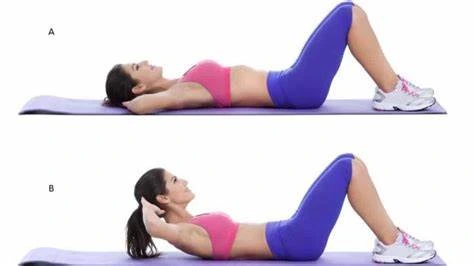
Stability ball sit-ups
By reducing pressure on the vertebrae and promoting the spine’s natural curve, a stability ball can help prevent back pain.
- Place your feet flat on the floor and take a seat on a stability ball.
- Bring your shoulders, back, and tailbone to the ball as you progressively lean back.
- Bring your elbows in, place the points of your fingertips in the center of your head, and then firmly press your shoulder blades together.
- Exhale as you use your core to move your body closer to your thighs and raise your upper back off the ball.
- Maintain this posture for a short while.
- Then inhale and slowly make your way back to the ball.
- Then unwind.
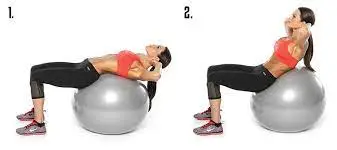
Bicycle Crunches
This type of crunch works the obliques, or side muscles. As you curl up, start as if you were performing crunches, pointing your left shoulder at your right knee. For the next repeat, point your right shoulder toward your left knee.
- Start in an upright position, flat down on the ground.
- As you lie on the floor, raise your shoulders and extend your legs.
- Stretch the opposite leg as far as you can while bending to one side and pushing one knee to the closest elbow.
- On the other side, go back to where you were crunching before.
- Then unwind.
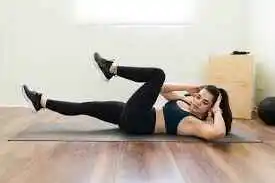
V-Ups
Strength, coordination, and balance are all enhanced by the workout. You can complete them if you want a more difficult task.
- Maintain an erect posture with your chest and legs.
- Elevate your torso to be level with the floor.
- Maintain this posture for a short while.
- Return to the starting position gradually.
- Then unwind.
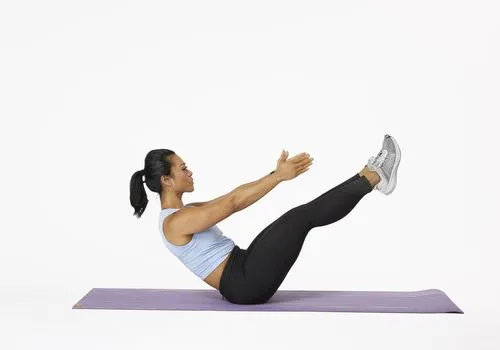
Decline Sit-Up
Put yourself on a decline bench and do sit-ups to make it harder. It gets harder to curl your body up as gravity drags you downward.
- You can change the setup’s difficulty by changing the bench’s angle.
- The exercise becomes more difficult as the decline bench’s angle increases.
- Sit on the bench with your knees bent, and place your feet beneath the padded bar.
- Fold your arms across your chest or wrap your fingers around the base of your skull.
- Raise yourself till your thighs and body meet.
- Maintain this posture for a short while.
- Then return to your neutral position.
- Then unwind.
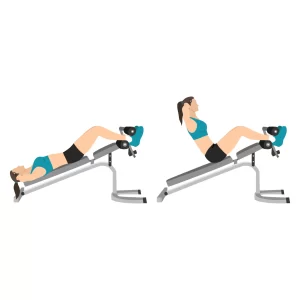
Sit up with your legs straight
Try straight-leg sit-ups as you work on strengthening your core. Instead of bending at the knees, put your legs in front of you and sit up straight as you usually would. By using more abdominal muscles and fewer hip flexors, this sit-up form strengthens the core.
- Keep your body level on the ground and freely align your legs.
- As opposed to a typical sit-up, the legs should not be bent at the knees.
- Place your hands on your sides as you remain supine and your head still.
- After taking a breath, raise your upper body off the ground by contracting your abdominal muscles.
- Once your spine is parallel to your body, slowly lower it back to its initial position.
- Then unwind.
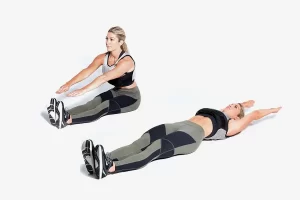
The following tips should be taken into account to guarantee safe exercise:
- Before exercising exercise, make sure your body is sufficiently warmed up.
- Stop exercising if you experience any pain.
- You should progressively increase the number of repetitions and length of your exercises to prevent overtraining and sore muscles.
- Use the right form when exercising to prevent injury to your body and to get the desired results.
- Try to wear clothes that don’t significantly limit your range of motion when you’re working out. Instead, dress loosely.
- Maintain a straight spine while working out.
- Before working out, it’s advised to take a deep breath and release it gradually.
When should you stop doing this exercise?
- Recent damage to the spine.
- Hernia in the abdomen.
- Just performed abdominal surgery.
- Weakness of the abdominal muscles
- If any pain arises during exercising.
- Lumbar region disc bulging
- This exercise is not necessary for people with lumbar retrolisthesis.
- If, after working out, your back pain becomes worse
Mistakes That Are Common:
Sit-ups are a complicated workout, as the following instructions make evident. Both beginner and intermediate workouts allow for a great deal of space for error because they need a high level of muscular control and body awareness. Remember to avoid these typical mistakes the next time you perform a sit-up.
- Craning of the neck
The “forward head” position is commonly used when executing sit-ups. When you crane your neck while performing sit-ups, you may have aches and pains or, in the worst-case scenario, a strain in your upper back or neck muscles.
- Crashing on the floor
During sit-ups, novices may inadvertently bump into each other when lowering themselves. This happens when your core is weak or you’re too tired to control the lowering phase. Since your lower spine won’t be in contact with the floor, the majority of the weight will be supported by your upper back. In addition to impact-related discomfort, lower back pain can result from sit-ups that involve a bent lumbar spine.
- Using excessive hip flexor
Sit-ups primarily involve the utilization of your hip and abdominal flexor muscles. When maintaining an upright posture, people with tight hip flexors may inadvertently activate their hip muscles instead of their stomach muscles. To strengthen your core, use more abdominal muscles and fewer hip flexors.
Summary:
Situps aid in the development and maintenance of a strong core, which is advantageous for various forms of exercise. Any total-body workout regimen that incorporates both cardiovascular and strength training would benefit from their inclusion.
FAQs:
What are the benefits of curling up?
Crunches, often known as curl-ups, strengthen the core and abdominal muscles. This includes the muscles of the upper and lower abdomen, as well as the erector spinal muscles of the lower back. Curl-ups also work the gluteal muscles. During exercise, curl-ups improve your stamina and build your abs.
Can I perform curl-ups each day?
Regarding your inquiry about performing crunches and push-ups daily, I advise you to go for it. If the weight is so heavy that you’ve created the perfect environment for overload and muscle growth, you won’t ever need to take a day off between exercises.
How many curl-ups do you do each day?
Three sets of 20–30 repetitions of sit-ups are the most effective method for toning and developing your abs. Even better, if you combine crunches with weight and aerobic activities, you just need to perform them three times a week.
What are the advantages of curl-ups?
The abdominal muscles can be toned, tightened, and built with the help of the sit-up, also called the curl-up. Though they also work the rectus abdominis, sit-ups are similar to crunches in that they condition more muscles and have a greater range of motion.
Does curl-up exercise help with abs?
With no additional equipment at home, curl-ups are a simple approach to strengthening your core. We’ll go over how to execute curl-ups properly below so you can start implementing them into your routines.
Are curl-ups considered a type of strength training?
The curl-up exercise is a common therapeutic method for building stronger abdominal muscles, but it still requires caution.
References:
Physiotherapist, N. P.-. (2023, December 13). Curl ups Exercise (Sit Ups): Health Benefits, How to Do? Mobile Physiotherapy Clinic. https://mobilephysiotherapyclinic.in/curl-ups-exercise-health-benefits-how-to-do/#google_vignette
Bariya, D. (2024, August 3). Curl ups Exercise (Sit Ups): Health Benefits, How to Do? Physical Therapy Treatment and Exercise. https://physical-therapy.us/curl-ups-exercise/
Cronkleton, E. (2023c, July 17). 9 Benefits of Sit-Ups and How to Do Them. Healthline. https://www.healthline.com/health/sit-ups-benefits
Ces, A. C. C. C. (2020, September 30). How to Do Sit-Ups. Verywell Fit. https://www.verywellfit.com/how-to-do-sit-ups-techniques-benefits-variations-5075764
DMoose. (2022, June 20). Straight Legged Sit Ups Can Make You A Fitness Beast | A Complete Exercises Guide | DMoose. https://www.dmoose.com/blogs/abs/straight-legged-sit-ups?srsltid=AfmBOooc5KE1w-_7g5sAciZ7RTpfdBqtSHN9kxnvMPb6yGARM72A6z8R
